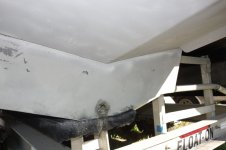Greetings J.M.
As you know, it’s a boat, so it’s ALWAYS something! But nothing worrisome.
I recently decided to replace the bottompaint on the aluminum bracket since it never lasts as long as that on the sponsons. I’m told that’s because copper is much more effective but of course can’t be used on an aluminum bracket. I had some spots with paint flaking off and tiny starburst zigzags of bare aluminum. I scraped the paint off with a pro scraper down to what was left of the barrier coat of Interlux 2000 (PO had the cans from the dealer). Sanded, cleaned then immediately applied self etching aluminum primer. Here’s the pic after that:

Then two coats Interprotect 2000 epoxy then 2 coats Pettitt Eco.
Starting at the bottom of the sponson (not bracket), note the drain and ducer screws are just drilled into the fiberglass hull (at least mine were). This is another ‘re-bedding’ job; note the length of the old screws, drill out an oversize hole, dental pick out any wet foam (likely none) and fill with x. My x is West Systems Six10 thickened epoxy cartridges, because it self mixes, can be ‘squirted’ in there, no waste (another self mix tube is $2) and it’s the easiest and most expensive. You’ll find many other x choices if you search ‘re bedding hardware.’
I’ve been told SS should not be used underwater (but what’s your propshaft made of?) and if the drain housing is bronze the screws should be bronze. Even Jamestown Distributors might not have that. Hope Bob will weigh in here. I used SS and check or replace them every season.
The external anodes on the engines, if like mine, are drilled into the engine and have an upside down handle appearance. I replace them with every annual service no matter how they ‘look.’ To check the remaining ‘mass’ (think bones with osteoporosis) you’d have to remove and weigh them, not wait until they look ‘half as big’ as when new. If I wait more than one season, the SS bolts get frozen in there and break off. Although the engine is bolted onto the bracket, there will be plastic spacers there as well as where the underwater portions of the bracket are bolted to the transom with big SS bolts. Bottom line, those engine anodes provide zero protection for the aluminum bracket.
If you don’t know the history for sure, I’d go ahead and replace the engine cavitation plate anodes as well.
So yes, the engine bracket should have it’s own anode protection. Mine is a Pooder (cheaper than Armstrong). It came with a 3 inch round CM-3 that fits in the hole pictured to the right. Put a bead of your fav adhesive sealant (I like Boatlife) in a circle on the top and bottom parts to keep water out of the hole and tighten the hex nut. This is much easier with two people with vinyl gloves…one sticks the bolt end up through the hole, the other spins down the other half of the clam shell from the upper access plate. This is another annual change out so don’t use 3M5200. I called the Pooder factory for this advice.
I also had some paint bubbling and flaking on the upper part of the bracket about five years ago. The experts pronounced it not galvanic corrosion, just normal paint behavior. Especially for paint that had behavioral issues to begin with. I had it stripped and re-done with a primer and non-slip paint for $800.
I recently noted minimal paint bubbling around the screw-on deck plates. I just chiseled off the bubbles, sanded, cleaned and immediately touched up with Rustoleum gloss white for metal (mixing up small batches of Interprotect 2000 epoxy is a pain). I just ordered Beckson replacement deck plates, since I don’t expect any O-ring to last 12 years when it gets submerged under 2 inches of saltwater while coming off plane. Here again we have SS screws into the aluminum in salt air and often under salt water. What could possibly go wrong?
Also, the aluminum boarding rail will not be the exact composition of the aluminum bracket and is secured with more SS bolts into the aluminum.
Lastly, the bracket drain plug was a ⅛” NPT iron pipe plug. I put Tufgel on all these and hope for the best. I just found ⅛ NPT aluminum plugs on Amazon but at $30 I doubt it’s worth it.
Hope this is helpful!
John

